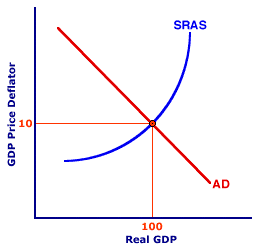
|
|
TRANSACTIONS DEPOSITS: A fancy, schmancy, official term for checkable deposits. This is the term typically used by the Federal Reserve System when they speak of checking accounts. The logic is that this are the accounts that are used to conduct transactions, that is, are used as money.
Visit the GLOSS*arama
|
|


|

|
                           AGGREGATE SUPPLY DECREASE, SHORT-RUN AGGREGATE MARKET: A shock to the short-run aggregate market caused by a decrease in aggregate supply, resulting in and illustrated by a leftward shift of the short-run aggregate supply curve. A decrease in aggregate supply in the short-run aggregate market results in an increase in the price level and a decrease in real production. The level of real production resulting from the shock can be greater or less than full-employment real production. While a wide range of specific aggregate supply determinants can cause a decrease in aggregate supply, the following rank among the more important:- A decline in the size of the population or a decrease in the labor force participation rate, both of which decrease the quantity of labor available for production.
- Depreciation of capital goods, which decreases the quantity of capital available for production.
- The depletion of existing mineral deposits or fossil fuels, both of which decrease the quantity of land resources available for production.
- A decrease in education which decreases the quality of labor resources.
- A decrease in technology which decreases the quality of capital resources.
- An increase in wages or energy prices, both of which raise economy-wide production cost.
Supply Decrease
Short-Run Aggregate Market | 
|
The short-run aggregate market presented in the graph to the right sets the stage for analyzing the effect of a decrease in aggregate supply resulting from a change in any aggregate supply determinant. The vertical axis measures the price level (GDP price deflator) and the horizontal axis measures real production (real GDP). The negatively-sloped curve, labeled AD, is the aggregate demand curve and the positively-sloped curve, labeled SRAS, is the short-run aggregate supply curve. The current short-run equilibrium, found at the intersection of the AD and SRAS curves, is a price level of 10 and real production of $100 billion.Consider what happens to this short-run aggregate market with a decrease in aggregate supply. Suppose, for example, that dramatic increases in energy prices cause equally dramatic increases in production cost. The result of this is a leftward shift of the SRAS curve. Click the [SRAS Decrease] button to illustrate. The result of this leftward SRAS curve shift is that a new short-run equilibrium is achieved at a higher price level (11) and a smaller amount of real production ($90 billion). This result is comparable to that for a standard market. A decrease in market supply results in a higher equilibrium price and a smaller equilibrium quantity. The key difference, of course, is that this "market" is the aggregate product market for the entire economy and not the market for a specific good. A comparative static analysis of the original equilibrium and the new equilibrium is useful and important. However, it is also instructive to dissect the adjustment process. - First, the SRAS curve shifts leftward due to the increase in energy prices. This reduction in aggregate supply creates an imbalance in the aggregate market. At the existing price level (which has NOT yet changed), buyers are willing and able to buy $100 billion worth of real production. Producers, however, are now willing and able to sell only $80 billion worth of real production. This creates economy-wide product market shortages.
- Second, motivated to fill the economy-wide shortages, producers increase production. In the short run they can do so, even if the original real production level is full employment, by tapping into frictional and structural unemployment and paying resources higher prices that create a temporary imbalance in real resource prices, which leads to an increase in the quantity of resources supplied. These actions, however, cause product prices and the price level to rise.
- Third, with the rising price level, producers increase real production, but buyers are induced to decrease aggregate expenditures. The combination of producers increasing real production and buyers decreasing aggregate expenditures act to reduce the existing economy-wide product market shortages. In fact, as long as the shortages persist producers increase production, which causes the price level to rise, which decreases aggregate expenditures. Eventually the rising real production and falling aggregate expenditures meet at the new short-run equilibrium price level of 11 and real production of $90 billion.

Recommended Citation:AGGREGATE SUPPLY DECREASE, SHORT-RUN AGGREGATE MARKET, AmosWEB Encyclonomic WEB*pedia, http://www.AmosWEB.com, AmosWEB LLC, 2000-2024. [Accessed: April 28, 2024].
Check Out These Related Terms... | | | | | | | | |
Or For A Little Background... | | | | | | | | | | | | | | | | |
And For Further Study... | | | | | | | | | |
Search Again?
Back to the WEB*pedia
|



|

|
WHITE GULLIBON
[What's This?]
Today, you are likely to spend a great deal of time at a dollar discount store trying to buy either car battery jumper cables or a dozen high trajectory optic orange golf balls. Be on the lookout for letters from the Internal Revenue Service.
Your Complete Scope
This isn't me! What am I?
|

|
|
The standard "debt" notation I.O.U. does not mean "I owe you," but actually stands for "I owe unto..."
|

|
|
"The roots of education are bitter, but the fruit is sweet." -- Aristotle
|

|
RPI
Retail Price Index
|

|
|
Tell us what you think about AmosWEB. Like what you see? Have suggestions for improvements? Let us know. Click the User Feedback link.
User Feedback
|


|


